Pallmann Magic Oil Review after 12 Years | 2025
It’s hard to believe it’s been 12 years since we wrote this blog post: Pallmann Magic Oil review. The response we received from that series of articles about using hardwax oils for wood floor refinishing has been incredible. A lot has happened since then.
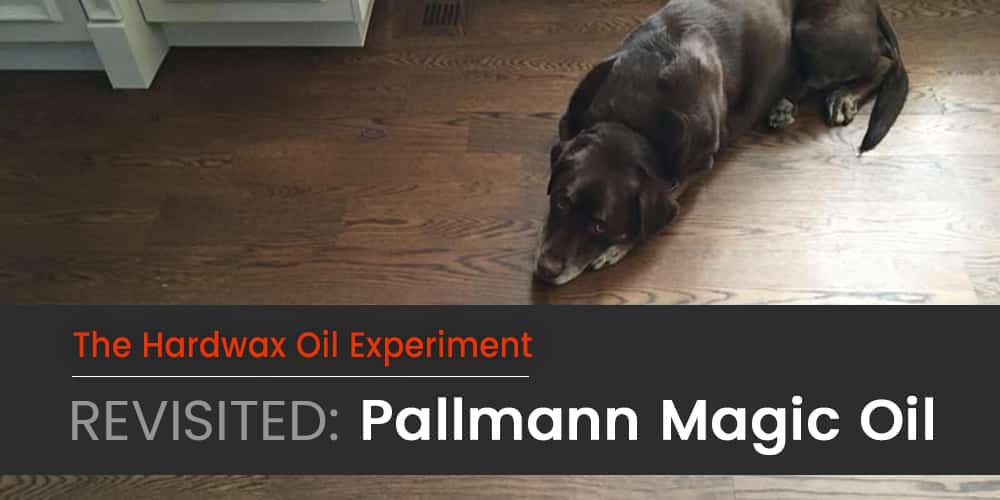
At that time, not many people had heard about hardwax oil and hardened penetrating oil finishes. And only a select few hardwood floor refinishing companies were offering them to their clients. We were the only Naperville hardwood flooring company using them.
12 years down the track and hardwax oil finishes have become extremely popular. They are now a very serious contender among mainstream wood floor finishes. It’s been fun watching their progress. We have completed over 150+ hardwax oil refinishing projects in that time… almost half of them Pallmann Magic Oil.
So I guess the big question is: What do we think of hardwax oil finishes now? How are they performing? Are we still using and recommending them for our hardwood floor refinishing projects in Naperville and Chicago? Are there any issues to be aware of?
In this article we’ll revisit our Pallmann Magic Oil review. In a future article we’ll take another look at our Rubio Monocoat review.
We’re happy to say the pretty much everything we wrote in the original Pallmann Magic Oil review still stands true today.
In that article we covered the basics of what we look for in a finish:
- Has to look good
- Must be long-lasting, durable to traffic and resistant to spills
- Have relative easy maintenance and repair
- Not “yellow” excessively over time
- Not have high VOC’s and stink up the home for days/weeks on end
- Not take forever to cure
We are still extremely happy with the performance of Pallmann Magic oil in covering each of these 6 points.
So how has it performed in the real life?
Some of Our Pallman Magic Oil Projects Revisited a Few Years Down the Road…
Below are some of the jobs we’ve been able to go back and revisit over the years in order to see how the Pallmann Magic Oil finish system was holding up.
Pallmann Magic Oil Project #1 – Elmhurst, Illinois
We sanded and refinished this builders showroom in Elmhurst, Illinois with Magic Oil over five years ago now. It’s one of our favorite colors – a process of the oak wood floors being fumed, stained and finished with Magic Oil. Here it was the day it was finished…
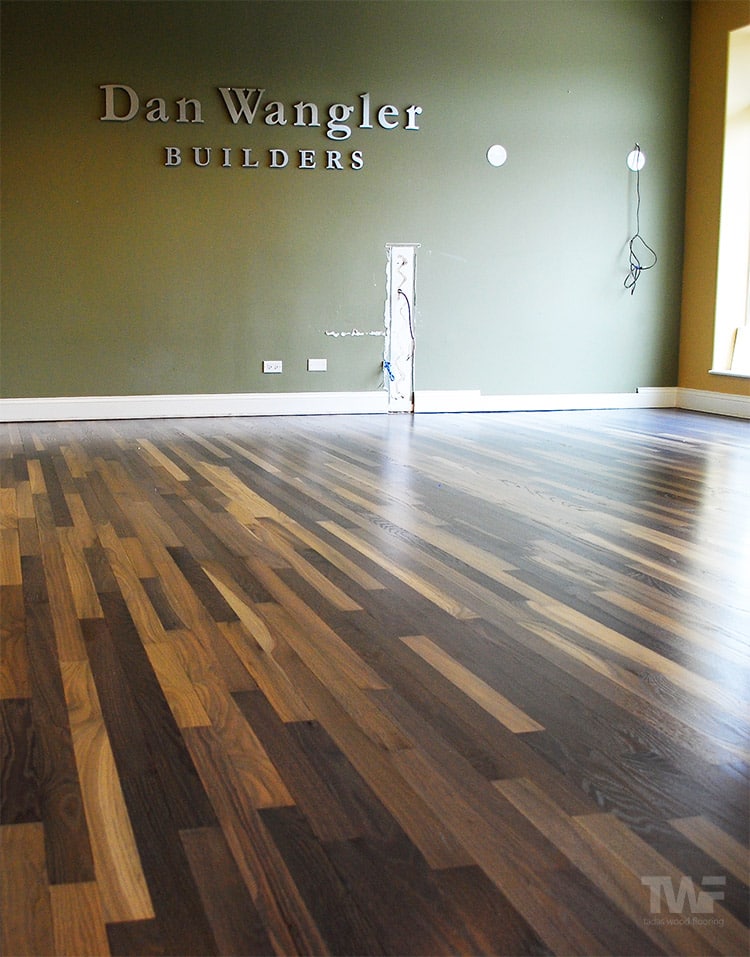
It gets quite a bit of traffic as any office and showroom would. We asked the owners, and nobody takes their shoes off (which makes sense for a public showroom). That means that snow, salt, dirt and grit get brought in and walked over the Pallmann Magic Oil coated floor on a daily basis.
How has it held up?
Extremely well as you can see in the photo below…
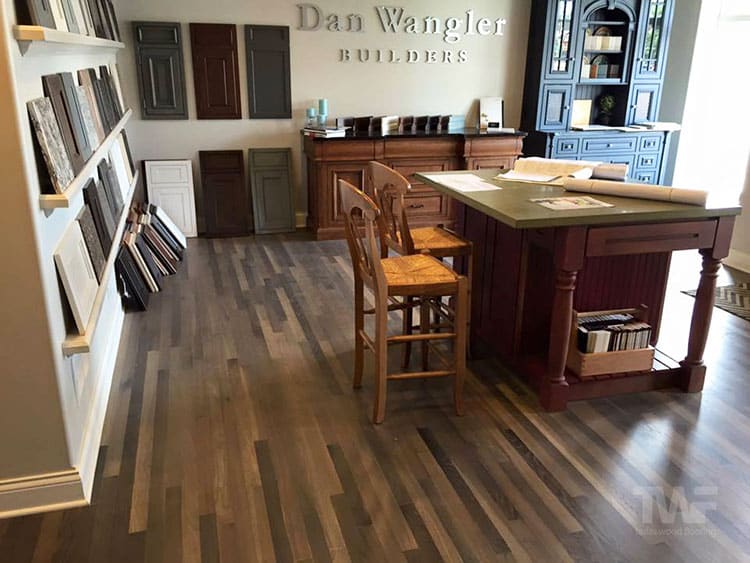
Pallmann Magic oil Project #2 – Hinsdale, Illinois
This hardwood floor in Hinsdale, Illinois was sanded, stained and refinished 4 years ago. A beautiful white oak floor, stained spice brown and Magic Oil applied on top. This is a very active home. A family of 5, 3 active kids and a large dog. A very high traffic home by anyone’s standards…
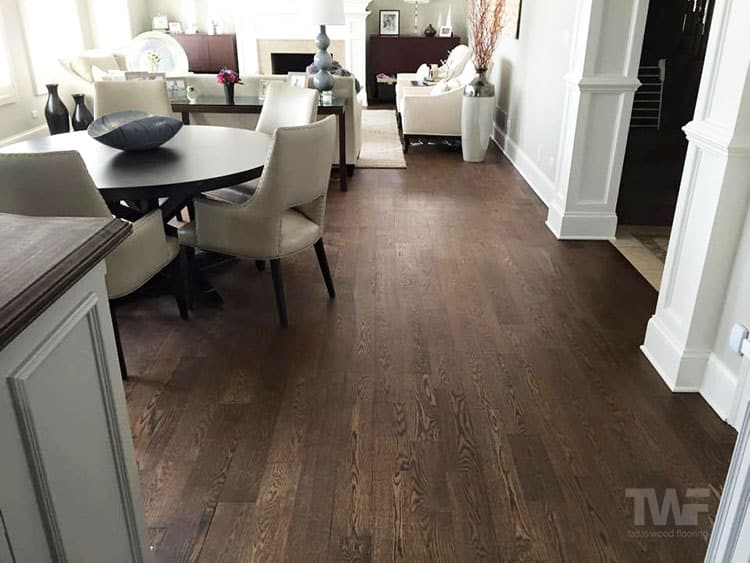
Looks good, doesn’t it?
Here’s their pooch looking very guilty…
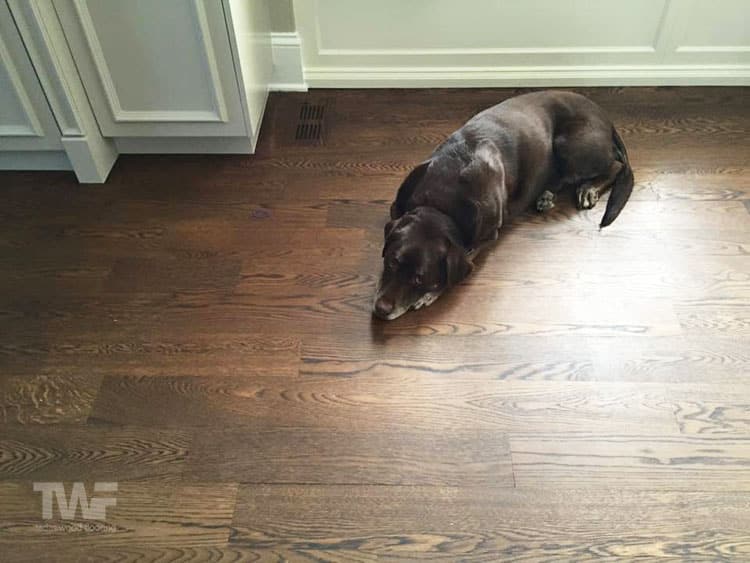
To show how much abuse these Pallmann Magic Oil stained wood floors get, last year, while we were back here installing and refinishing flooring in the hallway… one of their kids was riding his hover board round and around the hardwood floors in the kitchen.
This is a perfect example of why we love and recommend this hardened penetrating oil finish system so much.
Pallmann Magic Oil Project #3 – Naperville, Illinois
This photo was taken 3 years after we finished this Naperville hardwood floor refinishing project. Its red oak stained 25% Rosewood and 75% Golden Brown and finished with Pallmann Magic Oil. Unlike the above wood floor refinishing projects, this is quite a low traffic home. But they do have a small dog that scampers around on them…
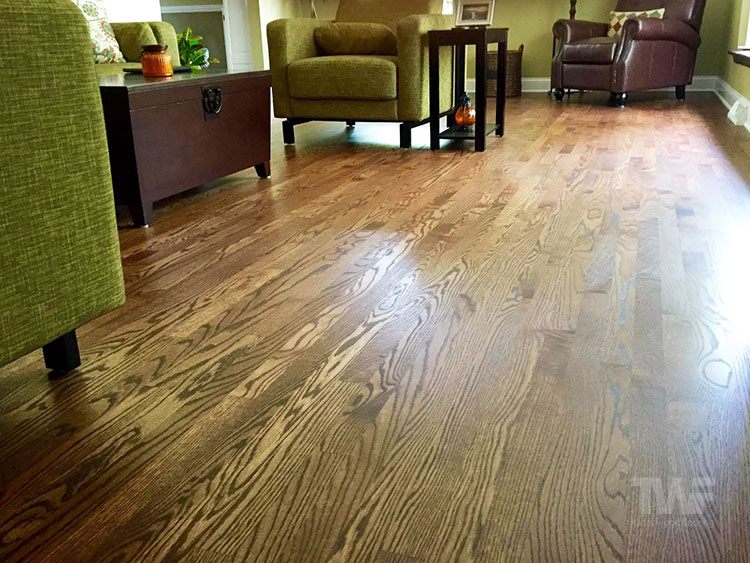
As you can see, the floors look like new. They have done a wonderful job looking after them.
Pallmann Magic oil Project #4 – My Own House
I love this hardened penetrating oil finish system so much that we used it in our own home. We did a glue-down installation of white oak in a herringbone pattern in the kitchen and family room, and straight wood floor installation throughout the rest of the house…
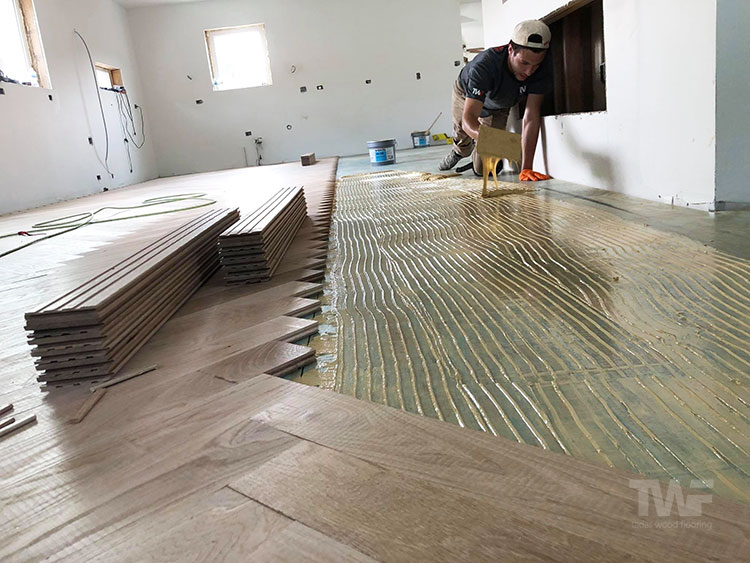
Beginning the Pallmann Magic Oil application over a dark stain…
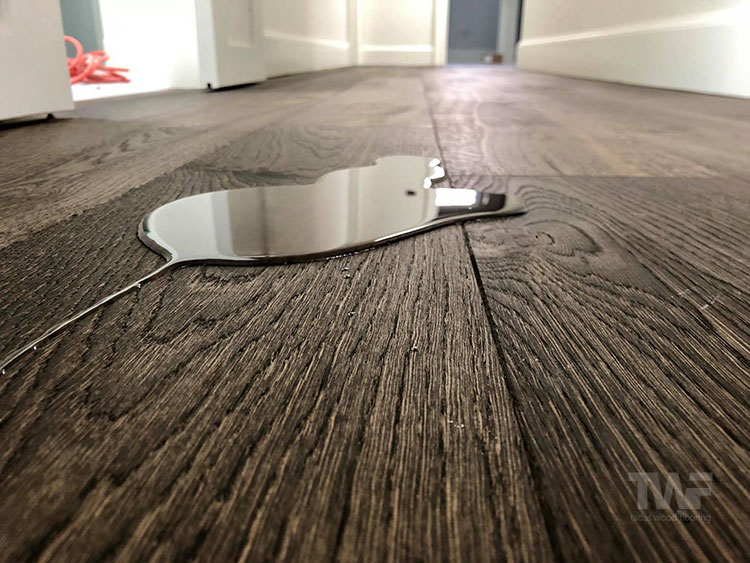
This is the finished dark stained white oak floor after applying Pallmann Magic Oil…
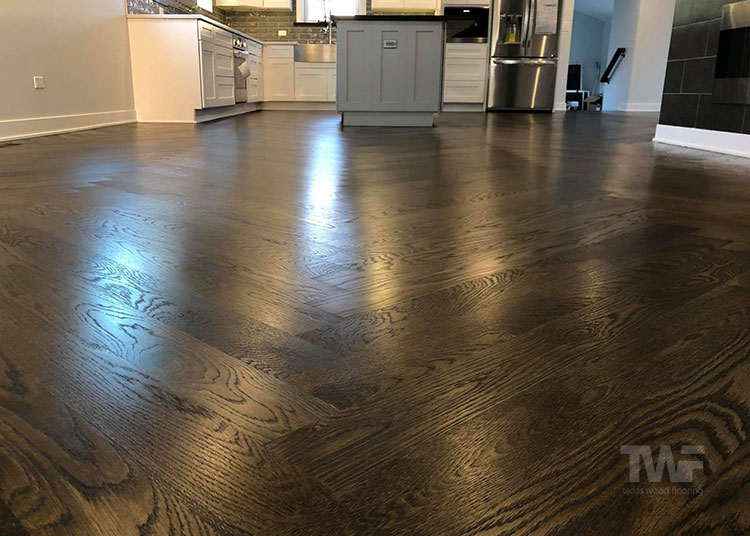
View of the kitchen with dark stain on the herringbone hardwood floors…
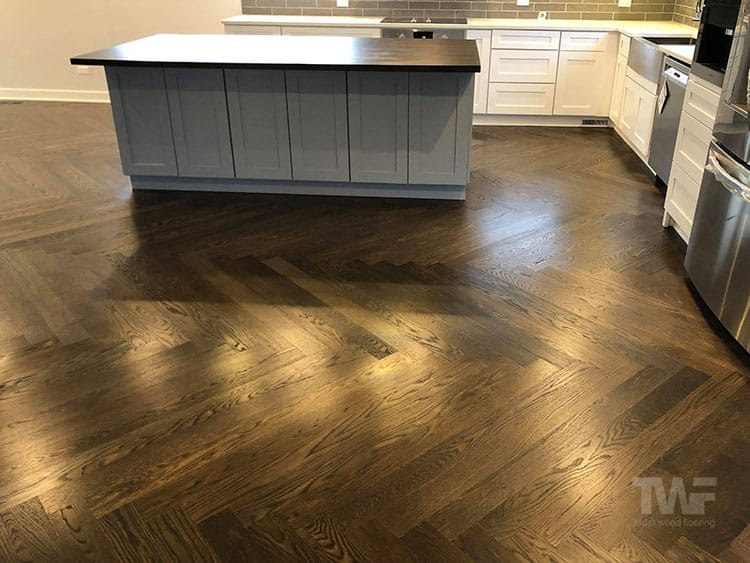
Here is the dark stained stairs and landing with Magic Oil…
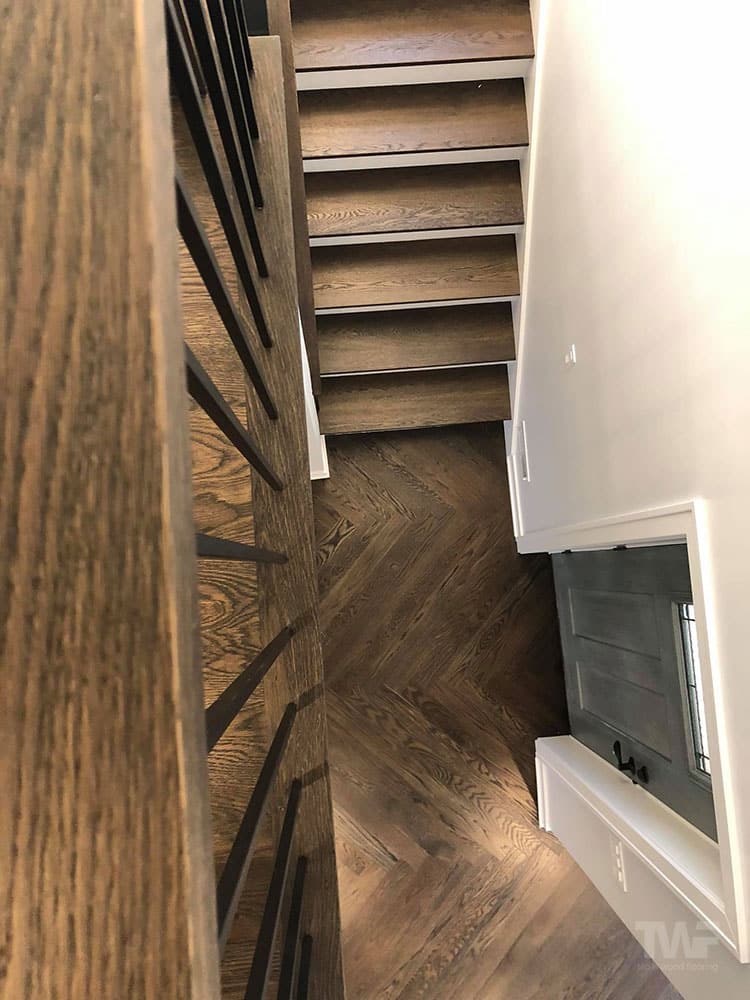
The straight laid wood floor hallway…
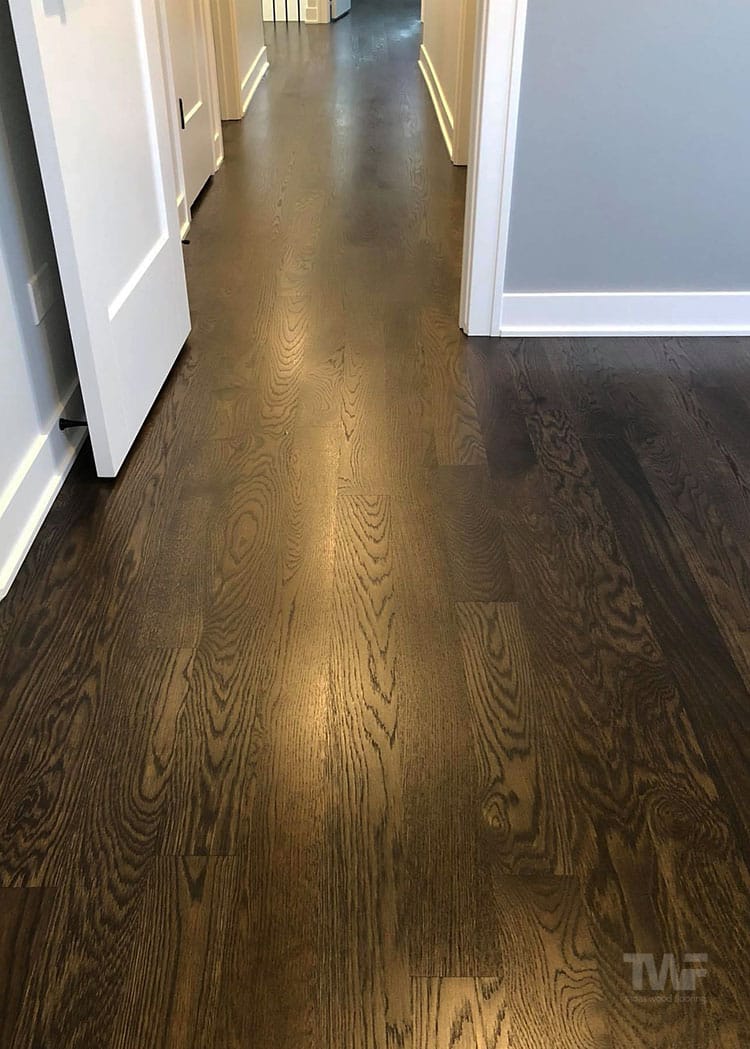
These floors are close to 3 years old now. We are a family of 5 with a growing puppy. You can see him in the video below doing a durability test on the floors…

We are super impressed with the looks, wear and durability of Pallmann Magic Oil on hardwood floors. And we now have ample proof that Magic Oil is a wonderful, long lasting and beautiful finish system in all types of situations.
If that’s the case, then…
Why Are There People Online Saying Their Floors Are Leaving Spots and Easily Scratching with Pallmann Magic Oil?
Yes, we’ve noticed that too. From the comment section of our original Pallmann Magic Oil article, and from phone calls we’ve received to help repair projects others have done, we see that certain people are definitely having issues with this finish.
Here are some of the issues that readers from all over the country have commented on in our blog…
“I am a homeowner who has had Magic Oil applied to existing red oak flooring, sanded down of course. I am so disappointed and am beginning to think that maybe something was missed in the application. I’ve got water spots everywhere and I cannot seem to remove them. Everytime I turn around there is another scratch or blemish. We have only had the product on a week and I think we are going to have it sanded down to the bare and start with something else. Any advice?”
That doesn’t sound good.
Here’s another one…
“We recently had new Red Oak floor installed and finished with Pallmanns Magic Oil. The floor guy did not have experience with product but was willing to try it. We ran into a couple problems and would greatly appreciate your opinion… it appears the finish is compromised in places, especially in the kitchen where we are seeing lots of spotting and ‘dry’ patches. The installer admitted the finish set up on him faster than he expected leaving excess oil on the floor. The installer was willing to come back and rescreen and spot re-finish. But that raised the question of how hard it will be for us to spot-fix ourselves in the future.”
Can you start to see the problem?
Here’s another comment that is more obvious…
“I went with magic oil to get a little extra sheen. Sanded to 120 grit, then applied two coats consecutively (spread on pretty thin with plastic trowel-like tool, left on for about 15 minutes, excess wiped off with paper towels, then buffed with a random-orbit polisher with microfiber cloth covering. Immediately repeated same steps with 2nd coat. After curing, it looks very blotchy – lots of uneven sheen, almost hazy/dry in some spots…”
We’ve seen quite a lot of these types of comments on other home renovation forums and Reddit wood flooring posts too.
If We Love This Finish So Much and Haven’t Had One Problem In 12 Years… Why Are Others Experiencing Such Issues?
What’s the cause of badly performing Pallmann Magic Oil floors that are leaving spots, patchy and blotchy areas and are easily scratched?
From our experience, 3 things in particular…
1. Inexperience in applying these types of hardwax oil finishes.
This is referring to both inexperienced wood flooring professionals that are practicing on client’s floors (a BIG no-no), as well as the growing group of DIY homeowners.
These wood floor finishing products are professional grade finish systems and take quite a lot of expertise and skill to apply properly.
Proper equipment to buff the hardened penetrating oil in, as shown in the photo below, is needed to do a professional job…
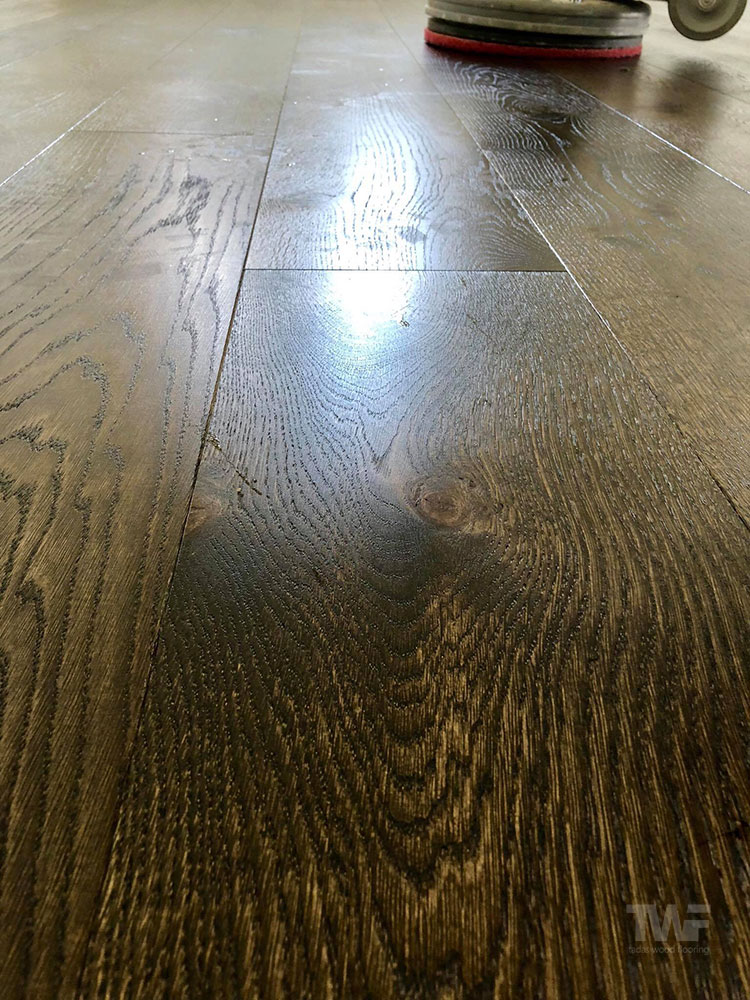
Yes, they can be done by a DIY homeowner that has some woodworking and painting skills and follows the manufacturer’s instructions… but (and please don’t shoot me), its most likely out of the realm of most weekend DIYers.
I say this because if even apparent hardwood floor professionals, with all the right tools available and years of experience with other finish systems, are having a tough time applying Pallmann Magic Oil properly… how is a DIYer, without these tools and skills, supposed to be able to. Just getting used to taming a buffer is a skill on its own for the uninitiated.
You can see in one of the comments above a DIYer used paper towels and microfiber cloths for buffing vs the recommended red and white pads. They also put 2 coats of oil down each time before buffing. Effectively applying 4 coats of finish. These are not the instructions Pallmann gives for applying Magic Oil properly. This will result in most of the oil being soaked up into the cloths and leaving too little to soak into the floor. Thus, resulting in a dry, patchy finish.
Any deviation from the professional instructions and tools will result in improper application.
Here is the second issue…
2. The hardwood floors are being sanded too fine
We sand up to 100 grit for Magic Oil floors. We have read of homeowners sanding anywhere from 150 grit up to 300 grit, and then applying Pallmann Magic Oil.
Higher grits are not better when it comes to sanding hardwood floors. Using high sanding grits closes off the grain too much. Sanding up to 300 grit will virtually polish the wood surface. Because the grain pores are now so tight, the oil won’t be able to penetrate and soak deep enough into the wood. This will cause bonding issues and failure of the finish.
And the last issue we see causing problems is…
3. Too much finish being left on the floor.
The chemical design of these types of finishes directs that in order for them to perform properly, they have to be applied in the exact correct coating sequence, in the right timeframe and all excess finish needs to be removed quickly before it dries and cures.
If you don’t have speed and experience, it can be quite stressful as the finish quickly sets up on you.
In one of the comments above you can see this was the issue for the inexperienced hardwood flooring installer that was using this on a customer’s floor for the first time. It set up on him too fast and he left excess oil on the floor – leading to a compromised finish.

Excess finish left on the floor won’t cure properly. It will leave the wood floor patchy, easily scratched and prone to water spotting.
If either of these 3 steps are done incorrectly – like the comments shown above – then yes, there will be issues.
Hopefully that clears up some of the confusion of why some are having issues… while experts in using these hard wax oil finishes are not.
Like all things in life, the more skilled someone is at something, the better the result will be.
Sanding and refinishing hardwood floors can be very frustrating, time consuming and costly when things don’t go right.
If you decide to have a go applying Pallmann Magic Oil yourself, please practice, practice and practice some more on large sample boards before taking a shot at your entire house. And even then, when you start, do the closets first, then the back bedrooms, then the main bedroom before starting on the more open and used rooms in your house. That way you’ll have some experience by the time you get to the living room.
If you decide to hire a professional hardwood floor refinishing company and they tell you they haven’t used these types of finishes before… seriously consider whether you want them practicing on your valuable wood floors.
Read this comment quoted above from our blog again if you doubt me.…
“We recently had new Red Oak floor installed and finished with Pallmanns Magic Oil. The floor guy did not have experience with product but was willing to try it. We ran into a couple problems and would greatly appreciate your opinion… it appears the finish is compromised in places, especially in the kitchen where we are seeing lots of spotting and ‘dry’ patches. The installer admitted the finish set up on him faster than he expected leaving excess oil on the floor. The installer was willing to come back and rescreen and spot re-finish. But that raised the question of how hard it will be for us to spot-fix ourselves in the future.”
I wouldn’t want you to be an unsuspecting guinea pig and lose time, money and years off the life of your hardwood floors. There’s enough of us professional hardwood floor contractors out there that know what we’re doing and have years of experience now. These inexperienced hardwood floor businesses need to do what we do and practice on sample panels in their workshop and on their own floors (every room in my houses, except for the one in the photos above, has a different finish).
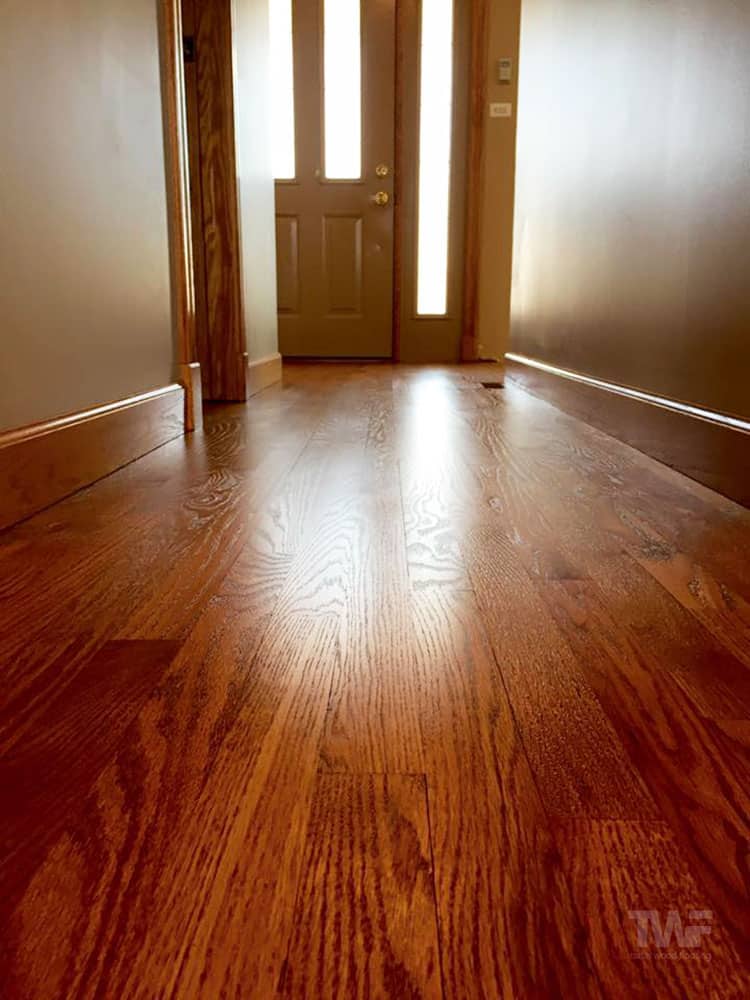
The photo above is another Pallmann Magic Oil floor we did a couple of years ago. It is red oak and stained Nutmeg.
And finally, we got around to it, (I know there are a few requests for this color in the comments) here is White Pallmann Magic Oil on red oak…
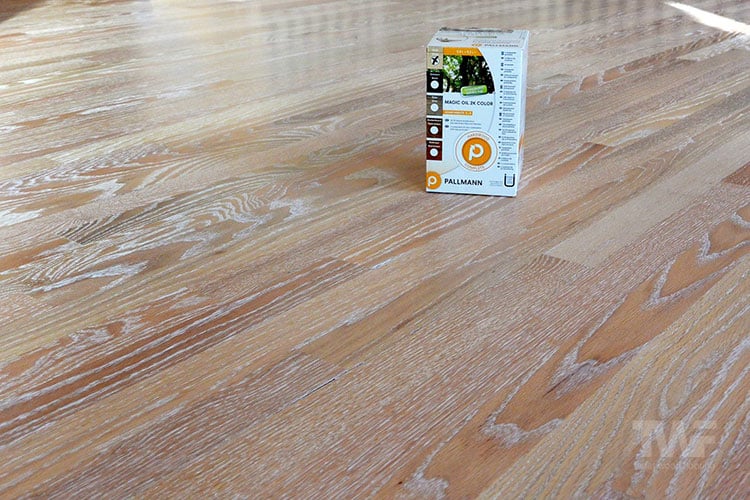
I’ve Heard Repairing Pallmann Magic Oil Floors Isn’t as Easy as They Claim…
Yes, we have heard this too.
Here’s one example from our blog…
“Unfortunately, we had some paint leak through one of our painting tarps and it dried in spots on our hard earned beautiful floor!!!! I tried several methods to remove the paint from the surface, but finally resigned to sand and repair the spots. My repair job did not work so well. I sanded the spots feathering them out a bit, restained, waited 24 hours and then reapplied the Magic Oil buffing in well. The spots that were repaired now look like scuff marks instead of blending in with the rest of the floor. Is this a sanding issue?”
In answer to her question… yes, it was a sanding issue.
When attempting repairs in Magic Oil, you need to follow the exact procedure done with the original sand and refinish. Use the exact same grit sequence and even the same sandpaper if possible. Then the Magic Oil should be re-applied in the same way and with the same number of coats as the rest of the wood floor.
If the hardwood floor was water popped prior to staining, then that needs to be done as well. Then the exact same stain (hopefully a sample from the original container) should be applied and wiped off in the same timeframe.
If you miss one of these sequences it won’t look right or blend into the surrounding area.
In some case’s it’s better to re-sand and refinish the whole floorboard. That way if there has been any UV damage, the whole board will at least be the same shade.
For our clients in Naperville and Chicago, we keep detailed notes of all our jobs such as sandpaper used, what processes were implemented, as well as samples of stains. That way, should they ever run into this issue, we can help them through the process… or be hired to do it for them.
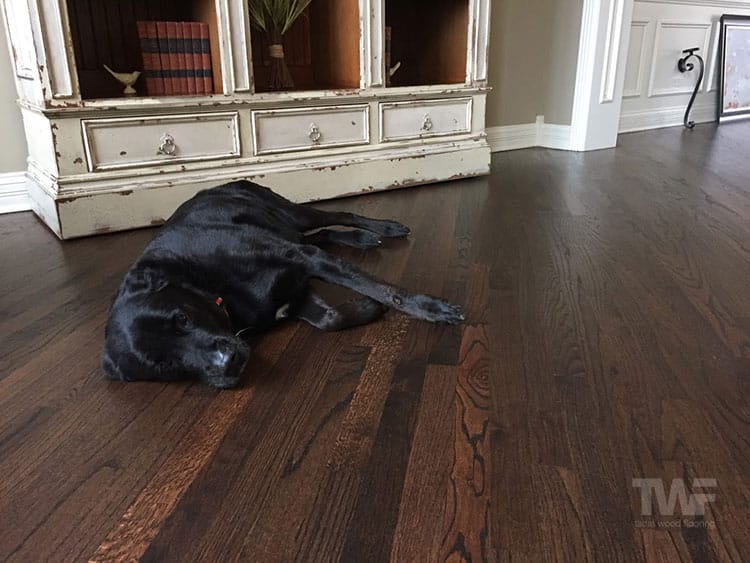
The Naperville hardwood floor refinishing project above was done about 5 years ago. This photo was taken almost a year later. Its Red Oak stained with 50% Sedona and 50% Ebony, finished with Pallmann Magic Oil. As you can see, they have quite a large dog and the hardwood floors still look great.
In conclusion…
Hopefully this Pallmann Magic Oil review gives you good, hands-on insight into the product so you can decide whether it is worthy of your consideration.
In our opinion it is one of, if not THE best, hardwax and penetrating oils on the market right now.
We love this finish system and stand behind it proudly. We’re happy to have been one of the pioneers in experimenting with and using hardwax oils in the Chicago and Naperville area. We intend to offer them to our clients for many years down the road.
We’ll have the 10+ year Rubio Monocoat review ready for you soon. Until then feel free to ask any questions you have about our Pallmann Magic Oil review, or share your experience with it (good or bad) below…
–
Updated January 2025

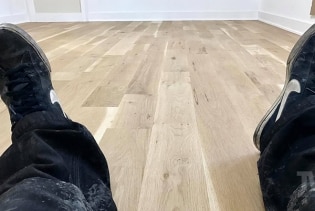
Thank you so much for the time and effort put into this revisit. Very timely as we are soon to be putting down our flooring and are trying to decide between Magic Oil and Monocoat. Eagerly awaiting the Monocoat review! Any idea when that should be up? :)
Hi Kimberly,
We always water pop before staining. We don’t use products like gel stains. You will see on most of the labels of these products that they are not recommended for using on floors… for good reason.
You can see our post on water popping here:
https://napervillehardwood.com/blog/what-is-water-popping/
Hope that helps :)
Tadas
Thank you so much for your help! Do you know by chance if one can use either a wood conditioner or gel stain (I read on a wood working site that this actually works better) to avoid blotching issues common to certain wood species? I know that it is possible to stain the wood prior to the Pallmann, but I am uncertain as to whether or not there is a way to simply eliminate the bit of blotching I am getting on my test boards with both Rubio and Magic Oil and if so is there a particular product that should or should not be used to do so.
I hate to bother you! I just can’t seem to find the answer anywhere.
Hi Kimberly,
It will be in month or so sorry. Way too busy doing ‘real’ work :)
As a heads up, the Rubio Monocoat Revisited post will be extremely positive too. To date we have finished 47 floors with Rubio and haven’t had 1 single incident. We – and more importantly our clients – love it.
I would say the deciding factors between the two will be color preference and sheen level preference. Rubio has more color options whereas Magic Oil has a higher sheen level.
Hope that helps make your choice a little easier.
Tadas
I’ve enjoyed following your blog posts for awhile now. Thank you for sharing your expertise & your valuable time!
Have you have ever had a customer that requested Rubio, and then changed their mind regarding the matte finish?
If so, are you able to go over the Rubio finish with a 2nd coat of either the Osmo or Pallman brand of hardwax oil?
Thank you
Hi Marybeth,
To answer your first question, no we haven’t as yet.
For the second question, no again sorry. You can use a polyurethane finish over top if you want more sheen. But this will take away the functionality of the Rubio and make it a surface finish floor.
Tadas
Thank you for your helpful information. When you mention stain and then Magic Oil, what brand of stain are you using? Does it change the Magic Oil sq/ft coverage or amount of time to setup before buffing off? We would like to use Minwax stain because we have raw hickory floors and the sample oil stain varies in color much more than the Minwax.
Hi Ruth,
We use Duraseal stains. It will change the coverage slightly but the time between buffing stays the same. Can’t comment on Minwax stains though sorry.
Tadas
How do you buff oil on stairs?
Hi Ruth,
We do it by hand. Pretty hard getting the buffer to work on the treads :)
Tadas
Hello,
Please advise on use of pallman magic oil if red oak floor is to be distressed by screw driver tips/ ice picks and back side of hammer for indentation. Then steel wool soaked in vinegar several hours and the liquid rubbed on to blacken before hand scrapping. This floor also has v groove. these recessed areas will remain blackened as will any we choose to leave behind with the flat plane hand scraping.
Duraseal for staining then neutral magic oil. Specifically will these areas recessed create any potential problems with the magic oil finish? How about additional drying time given these areas may “pool” the stain?
Thank you for your in depth website! This has been the single best source of information on oil finishes I have been able to find anywhere. I am forcing my very experienced but stubborn flooring contractor to read this before he partakes on my floor! Wish you would work in Cincinnati as your passion for your craft is impressive.
Hi Greg,
You should be ok with this. In the original Magic Oil review you will see a floor we did very similar to what you are describing. Look at the first 6 photos:
https://napervillehardwood.com/blog/the-hardwax-oil-experiment-part-4-pallmann-magic-oil/
You will want to use a rag to remove as much oil as you can from the oil from the grooves though. And yes give it a bit extra time to cure, just to be safe :)
Hope it goes well for you.
Tadas
Tadas,
I have to say you are certainly unselfish to spend the time you do sharing your knowledge and expertise with others and I have learned a lot reading your reviews and replies. I have a different situation from those I have seen on your site and would appreciate your advice. I have a non-commercial woodworking shop and I am replacing my current floors with solid wood 80% heart Caribbean Pine . So, I have been researching the best finish for this type of application. I fully understand that that no finish will protect the floors from the scratches and gouges to be expected in this environment, so a finish easy to repair is important. Also, of importance is some protection from spills such as wood stains and something that will not allow spilled glue to adhere strongly to the floor surface. Additionally, the faster the cure the better. From what I have read on this site I am leading towards Rubio or Magic Oil. The low sheen of Rubio is not a issue for me and the idea of the one application process is appealing. Of the finishes you have experience with, which do you believe would be the better option for my situation. Your assistance is much appreciated.
Hi Byron,
Personally, I would go with Magic Oil in this situation. It has a bit more of a wear layer and will probably be easier to remove the spilled glue from.
Hope that helps.
Tadas
Thanks for the quick reply. Magic Oil it is. Byron
You’re welcome Byron. Hope the project goes well.
Tadas
Hi Tadas,
I have just recently found your website and blog and have a question about Magic Oil since you are so knowledgable. I was wondering if floors that have been sanded and one coat of a protective oil based sealer applied, can have Magic Oil used as the final finish? I am doing a restoration project and for several reasons, the floors needed to be sanded. The floor guys wanted to put one coat of sealer to protect them. They are now covered and we will not be ready to do the final finish for probably a month. Before i ask them about Magic Oil, I thought I should know if it is even possible to use it at this point.
Thanks, Debra
Hi Debra,
Unfortunately it won’t be possible. It can go over stained floors but not another oil based product sorry.
Tadas
I was afraid of that. Would it have been possible to do that with the Magic Oil if I had started with that? By that I mean, if the first coat had been Magic Oil, could the second coat have not been put on a month later to finish? Also, if you don’t mind, I would love to have your opinion on another floor. I wish you were in the South so I could hire you but since you are not, thank goodness you have this wonderful blog! I have another project, a historic house with 150 yr old heart pine floors that are in horrible condition. Once they are sanded, they will, as you know, be red. I would like to kill the red as if they have no stain or finish on them and have a mellow, worn patina. Not weathered like they have been outside but aged like they would have been all those years ago. I think a hardwax oil finish would be perfect but I do not know how to achieve the color, or lack of color, and neither does anyone I have talked to around here. Most of the time here, even on the antique heart pine floors, everyone puts a glossy polyurethane finish. I think a worn, natural look would be beautiful if I could achieve it. Does this make sense to you and do you have any suggestions as to how I could accomplish this?
Hi Deborah,
Technically yes you could have done that. We most likely would apply 2 coats first (for better protection) and then a third coat later on would be possible.
For your other floors, I would look into Rubio Monocoat Fuming or even their Pre-Color Easy product. You can read about it and see the effects here:
https://napervillehardwood.com/blog/rubio-monocoat-pre-color-easy/
And yes I agree, a “worn, natural look” would look great.
Hope this helps.
Tadas
Thank you so much for your help and advice! I have actually decided to go to the closest town that sells both products tomorrow to check them out and get some samples to play with. I agree Rubio sounds like my best bet for the look I want and I so appreciate your guidance. I wish we had someone with your knowledge of floors and products in this area. It is admirable that you spend your free time sharing your expertise and helping people with their floor problems and situations. Thank you again, Debra
I am re-sanding my outdoor covered porch as areas from the Virginia sun have become black and the finish destroyed, leaving bare wood exposed. The entrance and stair areas that are black are in direct sun for certain times of the day. Rubio exterior products are not available in our area. Can you please recommend a product similar to Rubio that I can get at Home Depot or Lowes? I have ordered Rubio but the sanding may be done prior to Rubio Monocoat Hybrid Exterior arrives. I ordered Rubio after the over night deadline. The weather is a factor in getting this done so waiting for Rubio to get here may not be an option. Thank you in advance for your response.
Hi Michele,
Sorry for the delay in getting a reply to you, it’s been a busy couple of weeks here. I’m sure you have found a product by now. We aren’t really experts in exterior finishes sorry. I have heard that Sikens has a pretty good reputation though.
Sorry I can’t be of more assistance.
Tadas
Can you apply Pallman white hardwax oil over duraseal stained floors? Everytime I see that Pallman hardwax oil can be applied over a stain it always says the natural hardwax oil.
Hi Cindy,
Not 100% sure to be honest as I haven’t tested it. I’m sure it’s possible if done right but I would do a sample up first to make sure.
Tadas
Thank you so much sharing your knowledge and experience. I live in Charlotte, NC. Sounds like the key to good outcomes with Magic Oil and RMC is excellent preparation and execution of the application How do I find a floor refinisher as good as you?
Hi Nina,
Sorry for the very late reply. First thank you for the nice compliment :)
To find a good business, I would look on Google for floor refinishers in your area and get at least 3 to come over and give you a quote. Ask them the questions outlined in the free guide here: https://napervillehardwood.com/guide.html
Also have a look at their Facebook profile for pictures of previous work and read their reviews (although we know of many businesses that buy fake reviews so be a bit cautious there.)
I hope you find someone great for your floors.
Tadas
Great site! Thanks for sharing your experiences over such a long time. I have a magic oil finished (professionally) floor just over 18 mos old and it still looks amazing. I too have a question about magic oil white. Do you have any example photos you can share? Looking at doing just the white finish over rift sawn white oak and am wondering what it might look like and any tips to getting that “Nordic” look. Thanks.
Hi Pat,
Sorry, we haven’t done a white magic oil floor yet. Maybe down the road though. Just need a client to request it :)
Tadas
Tadas,
Need quick advice if you can for an ongoing work.
I am getting my red oak floor refinished with duraseal stain and pallmann magic oil. Contractor put the samples on the floor, it feels very rough, perhaps from the water popping. Floors has been sanded down. He smoothened the sample area with screen mesh and then water popped and the applied the samples. The screened section felt really smooth, but not so after sample were put.
Contractor assures that after he does 3 application of pallmann with red/white pads it will feel smoother but never like the screened feel.
1. Is there any tip you can provide to get a silky/smooth/velvety finish? Can maroon pads be used between application for a velvety finish?
2. How can I get similar finish on stair handrails where its not possible to use machine?
Thx.
-arun
Thanks for the answer on this one — I’m preparing to finish my first floor, and was concerned about the raised grain from water popping on the samples I’ve made. I thought it would buff out with the Red / White pads, but good to hear some confirmation on this. There’s very little good info on the web regarding the finer points of using Magic Oil. Cheers.
Hi Arun,
Yes the first coat will always feel a bit rough. As you said , it’s due to water popping. This is always sorted out with buffing between the following coats. It should end up smooth like you want if done right. I’m sure your floor guy will know what to do.
For the handrails it will mean a lot of hand buffing. A lot :)
Hope they turn out well.
Tadas
Thanks Tadas. Floors have come out really good, love the feel. I learnt a lot about HWO finish from your site that helped make choices, thanks for the informative site.
Handrails are turning out challenging. Earlier it was lacquered, and it felt smooth and grippy. Now with Pallmann Oil, it feel rough and slippery. Rough is understandable, but slippery is worrisome, because handrail should provide grip to help you stop a fall.
Any thoughts on how I can recover this?
-arun
We are trying to decide between Osmo and Magic Oil for our White Oak character floors with Bona Nutmeg stain. Do you have any thoughts or suggestions?
Hi Charlie,
Both finish systems are good and the nutmeg stain will look great under either of them. I would go for the finish your floor guy has more experience with.
Tadas
Hi Tadas! Thank you for sharing your knowledge! We are in the process of building our home and have a large venthood cover that is made from rustic walnut. Obviously we can’t run a buffing machine over it but we could get a handheld one for the larger areas and handbuff the more detailed and smaller sides. Is this what you would recommend? I also noticed it’s rated to be used on heated floors so do you think it will hold up with the heat from the cooktop? The hood has about a three foot clearance above the cooktop. Thanks again!
Hi Kim,
That’s a new one for me but I can’t see why it wouldn’t work. Yes you should be able to hand buff. It cures in 24 hours so after that it should be good. Maybe do a test sample first and put it beside the cooktop to see how it performs.
We will use Pallman oil for our white oak floors. First we would fume it to make it gray with Rubio and then use two coats of gray Pallman oil. Do you think it is a good plan? We want that modern gray hardwood look that is so popular these days.
Hi Viktoria,
Sorry for the delay. I’ve been on a bit of a break from the website, too busy with work.
Yes you can definitely use fume first and then apply grey Magic Oil. Should look great. Remember to test an area first though. And practice with the fume if you’re doing it as a DIY project. It’s not easy to apply evenly.
Tadas
Hi Tadas,
Thank you for all the wonderful advice you post! I just had my oak floors refinished with Magic Oil. The floors are “patchy” in appearance (some areas have an oil sheen and other areas do not). Also there are swirl marks from the oil. What went wrong and how can it be fixed? Thanks!
Hi Mary,
Sorry you’re dealing with this. It looks like it wasn’t either sanded properly, applied properly, or both.
Unfortunately it’s very hard to diagnose the issue without seeing it in person. If it’s just the application, then the excess oil needs to be fully removed, buff the floor and apply a new even coat.
Hope you can get it sorted.
Tadas
Getting ready to install approx. 2,000 SF of reclaimed/antique heart pine. Trying to decide between Woca, Waterlox, and Magic Oil. So far I haven’t put any Magic Oil on any sample wood – I like Waterlox over Woca (in appearance). Just curious if you have any experience with 100+ year old high resin heart pine and any finishes you might recommend over another.
I’m sure David already solved his issue, but for others who might read this, I used Waterlox about 10 years ago on a wide-plank softwood floor, and it unfortunately has not held up well. Waterlox does not form a very hard film and wears fairly quickly, leaving bare wood in high-traffic areas. It looks fabulous and rich when it first goes down, but doesn’t hold up. I am getting ready to do a refinish, and next time I’ll use Magic Oil, I only wish it was available when I did the first finish.
Hi David,
I’m not an expert on Woca or Waterlox sorry. On that note, we don’t have much experience with reclaimed pine either. I will say what I say to everyone here, get some sample finish, some scrap boards and do a series of tests to see which one you like the best.
Sorry I couldn’t help more.
Tadas
Hi Tadas,
First of all, thank you for the highly informative blogposts. Hoping to get your advice, as it looks like you have a fantastic understanding of your craft and trade.
First off, this is a CABIN so we have a different standard than if this were a project in our own home. For that reason, we are looking to refinish the 1960s floors on our own, with a solid understanding that we will not do the same quality of job as a flooring expert. That is partly why I am seeking your opinion as the product we choose will likely be key in ensuring we get acceptable results. We are pretty fastidious and detail-oriented so hopeful we will do an adequate job.
Floors are tongue and groove, 2×6, post and beam construction (no foundation underneath), no insulation. We are in the Pacific Northwest, so a fairly damp climate. There are gaps between the boards, which we will not be filling – too labor intensive, considering this is a cabin, the gaps also provide character to the flooring.
We don’t believe there was a finish on the floors previously but we cannot be sure however we have sanded the floor in preparation for finish. Our concern is the gaps and what product will be forgiving.
Additionally since this is a cabin, the flooring will not experience consistent humidity, temperature,etc. While the flooring will not get wet, it almost is akin to a covered porch than an interior application.
We have waffled back and forth between considering Pallman’s and/or a more traditional poly finish using a product such as Duraseal. Due to application technique and the gaps, we are wondering if we ought to consider an exterior product such as Cabot Gold or similar since it can be applied with a brush in lieu and it might be more resistant to the humidity fluctuations. We are concerned the poly or Magic Oil may flake or bubble due the humidity/temperature changes. Help! Any additional insights?
Hi Kristina,
Have you seen this product:
http://rubiomonocoat.com/en/p/products/exterior/7-protection/colours-and-protects-in-1-single-layer/42-rmc-hybrid-wood-protector?
I have no experience with it, but it looks like it could be perfect for this project.
Tadas
Tadas:
Thank you for your amazing blogs and the time you spend to answer questions. I have been reading for 2 days now trying to find the answers but I feel I haven’t found a situation quite the same as mine.
We just installed a 300 SF reclaimed wood floor that is rustic in character (we consider desirable). The reclaimed job was 100% DIY so the boards are not milled or planed to even out the thickness and warpage. The planks are variable width from 8 to 10 inches. They do not lay perfectly flat on the floor due to thickness and warpage so the result is larger gaps in some places than considered normal. We do not intend of filling these. I read in one of your blogs that floors with wider gaps are a concerns when using a HWO but I want the matte finish with little to no buildup of a HWO.
I watched the Pallmann Magic Oil application video which seems a little friendlier than the Rubio system (maybe because the Rubio system is one step and seems more rushed than the other process). Can you advise if one of those would be better for my application than the other with the gaps and imperfections and being a DIY project? Or is there another product that might be more forgiving? One other important thing is that I want the natural light color of my wood to remainso I am concerned about the product darkening my floor. Any advice would be appreciated. Thank you!
Hi Laura,
You floor sounds like it will be a challenge to coat in the traditional way. I don’t think you will be able to use a buffer if applying a hardwax oil. They most likely will need to be done by hand, which will take a lot of extra effort and time.
You also said you would like the “natural light color of my wood to remain”. That can be a challenge too depending on how light you want it to be.
My suggestion would be to have a look at a product called Bona Naturale. It is a very matte water-based finish system that looks similar to a hardwax oil finish. It will be easier to apply and have the looks you want. You will want to roll this finish and not t-bar it though. Otherwise you’ll lose a lot in the gaps.
Hope that helps.
Tadas
What is the best finish to resist UV rays from fading my oak floors that I am going to have refinished?
Hi Chuck,
A high-quality, commercial grade water-based product is most likely your best choice. But there are many other things to consider too if you want to protect them from UV rays:
https://napervillehardwood.com/blog/sunlight-and-fading-hardwood-floors/
Tadas
Hello Tadas! I can’t tell you how helpful your blog is and how much I appreciate you sharing your knowledge. My family just moved from Chicago to Connecticut, or else we’d hire you in a second! I’m hoping to get your opinion on something. We recently purchased a home with beautiful floors (oak, we believe). I’d just like to stain them a couple shades darker. We have two kids and it’s very important to me to use low VOC stain. That being said, I like deep, rich floors with some shine, and our boys are pretty hard on floors. What would you recommend using? When you say you sometimes use stain under the Pallmann Magic Oil, which stain do you use? Thank you!
Hi Ryanne,
We mainly use Duraseal stains. And yes, they can be used under Magic Oil :)
Tadas
As we’ve magic oiled white oak in stages of our remodel, I’ve appreciated your blog and advice, which has made for a largely successful application.
However, on the first coat in a recent room we’ve completed we likely went too long beyond the “mix time” of the magic oil (60 min), and in the final stages the oil became a bit too sticky and left a bit of an excess that hardened on the surface rather than soaking in. Do you recommend a method to buff down some of these surface patches without damage to the entire surface?
Hi Jonathan,
Unfortunately you will need to screen or lightly sand your floor to remove those spots and then reapply another top coat.
Hope that helps.
Tadas
Hi, I am wondering if you can tell me what color you used in Project #1 – Elmhurst, Illinois. I have cherry cabinets, similar to your island in the photo, and am having a hard time finding a floor color that will work. The one in the photo looks perfect!
Hi Lisa,
This is a custom, multi-process color. It uses a custom made pre-treatment, plus fuming and then a stain. Not easy to do or replicate unfortunately. Sorry.
Tadas
Hi Tadas,
Thank you for sharing such helpful information. I have a question that I wonder if you have run into. I have R&Q White Oak floors that were factory wirebrushed and prefinished. The finish was some kind of “reactive stain” to just slightly warm the tones, and then a UV cured WOCA oil. They are beautiful; however, we are getting some spots where the dog drips water, and under where the christmas tree was – even though it had a towel underneath and we were careful about keeping it dry, I can only assume some dampness got there. These spots don’t quite look like a lifting of a wax, but instead look like the reactive stain gets washed out underneath.
I am wondering how to “fix” this, or at least prevent further incidents. Does it just need a buff with more WOCA? Or can something like Pallman’s or Rubio be applied over WOCA? Perhaps I may need to give it just a light sand or buff as it is wirebrushed after all?
Any suggestions would be appreciated.
Thanks
Marc
Hi Tadas,
I thought I would check in with you, since this is such a useful site for all. I’ve finally had it with WOCA. I think that the initial factory UV-cured WOCA oil is not good. I’ve used all WOCA care products and I’ve tried all recommendations – even doing a maintenance coat with WOCA Diamond oil. After 6 months, I get stains and floor looks splotchy.
After consulting with Pallmann’s I am refinishing with Magic Oil. Pallmann’s did say they have had success applying Magic Oil over WOCA if they are cleaned well first (Using either Pallman’s or WOCA intensive wood cleaner (which I have on hand so is what I am using).
I did do a test board that I had leftover from initial floor. I tried various sections
– factory woca only
– factory woca + woca diamond maintenance coat
– factory woca + MO
– factory woca + woca diamond maintenance coat + MO
– sanded section with only MO
In ALL cases, I tried various stains (vinegar, ammonia, simply green, coffee, …) Simply green and balsamic vinegar stained all samples EXCEPT for the ones with MO as the last coat.
I am going a bit extra and screening the WOCA floors with 100grit and then applying the Pallman’s. First room looks great so far (and definitely a noticeable sheen difference).
I do notice that the initial sheen of MO is more like a semi-gloss, but tends to get more eggshell after a week or two… Is this what you seen as well?
Thanks,
Marc
Hi Marc,
Sorry to hear this. We don’t have any on-site experience with WOCA unfortunately. And we wouldn’t suggest mixing finish systems as it will lead to more issues.
I would suggest getting in contact with the manufacturer or WOCA directly and see what they suggest. Have you used maintenance coats? These penetrating finishes need maintenance from time to time to keep up the protection. Again, not certain about WOCA though sorry.
Hope you can get it sorted.
Tadas
Tadas, awesome blog!
I want to use Magic Oil for the ease of repairs, and as much sheen as I can get in a product like this.
Why do you stain under Magic oil so often, rather than using the Magic oil colors? What type of “stain” does the Magic oil use? Does staining or Magic oil colors perform better agains UV fading? You must feel comfortable that enough of the Magic oil absorbs into the floors – do you do one or two coats of Magic oil over a previously stained floor.
Thanks again for the awesome blog!
Hi Mark,
Mainly because those are the colors the clients want and they can’t get it with the limited Magic Oil palette. We do 2, sometimes 3 coats over the stain. Depends on the project.
Glad you enjoyed reading the blog :)
Tadas
Hey Guys,
Great articles! I am a DIY’er, about to install 2nd grade Maple unfinished flooring into the kitchen of our 1890’s house. The subfloor is brand new and flat. We do have a dog, and kids. I’m all for the wax/oils in lieu of poly and love the more flat natural feel. Which of the oils tested do you think would be best on Maple and easiest to apply? Best durability, no water staining is another concern in the kitchen. Am I asking too much?
Thanks, please keep up the great blog.
– J.T.
Hi JT,
I would probably go Rubio Monocoat if you want a hardwax oil. If you want the flat/matte natural feel and the durability of a two component water-based finish then take a look at Loba 2K Invisible Protect A.T.
This could provide the best of both worlds for you.
Tadas
5 months ago we had 2500 square ft. of old growth walnut wood flooring installed in our newly renovated home. Our supplier recommended finishing the floor with Rubio monocoat. We felt our builder who has installed and finished many hardwood floors was capable of finishing our floors. We all watched the you tube videos and spoke directly to the retailer and Rubio district representative to have all if our questions answered before beginning. The wood had sat for over two months to acclimate to our dry climate and installed beautifully. The sanding process went well as did the application procedure as directed by Rubiocoat. After the first coat the finish dried patchy with dry and shiny spots. A second coat was applied in the same manner as directed and showed some improvement. It took two more coats to get an even finish. From the moment we could walk on it, the floor has shown every footprint, it scratches at the drop of a hat, and seems to be magnetized when it comes to hair, dust and dirt. The over all appearance is dull, splotchy and dirty looking. Cleaning it with the Rubio soap only has dulled the floor more. We are sick over the money we have invested in these floors and the Rubio coat products, only to end up with a floor that is literally a nightmare to look at each day. Short of sanding the entire floor, two sets of stairs (17 steps each) and completely starting from scratch, do you have any suggestions for a fix?
Hi Dave and Tadas,
We are also having a similar issue with seemingly too much oil applied. The contractor recently followed the guidance from Rubio for a “renovation” (using maroon pads to buff excess oil, then cleaning and adding a small amount of 2C) overtop. We are now at 3.5 days post application, and still not able to walk on the floors without footprints showing. It is unfortunate because this is a contractor recommended by Rubio, and they said they have done many floors in the past, so lack of experience doesn’t seem to be an issue here. Our floors are also walnut, though Brazilian walnut. Wondering if Tadas you have any experience with. The renovation process?
Thanks for your informative blog and sharing your knowledge. Seems to be one of the best places to find info!
Sarah
Hi Dave,
So sorry this has happened to your floors. It must be super frustrating. From what you have described (without seeing the floors in person) it seems like too much finish has been left on the floor. It really needs to be buffed out thoroughly within the limited time frame. Unfortunately this is a specialized product and is not as easy as just applying polyurethane as your builder has found out.
Because you have applied the soap on top, you won’t be able to reapply the oil and try to buff it again (which may not have worked anyways). The only solution is to either clean then as best as possible and apply a bonding agent and a waterbased finish on top (not recommended but the cheaper option)… or re-do the floor entirely.
Sorry for the bad news Dave. Unfortunately we hear these stories too often with builders that don’t have specialized skills in these products.
Hope you can find a solution.
Tadas
Hi Tadas –
I recently had my floors (~2500 sq ft) refinished in Magic Oil tinted (5 BlackBrown : 1 Grey). The floor was water popped after sanding. The contractor claimed to be experienced and had installed many hardwax/oil floors. On the first attempt, he made numerous obvious mistakes with resulted in a complete re-sand. On the second attempt, the first coat came out perfectly. Exact color and sheen we were looking for. We were thrilled. However when they put down the second coat 24 hrs later, it completely changed both the color and the sheen. We ended up very dark, almost a dark caramel color rather than what it looked like after the initial coat and the samples we did before they started. Secondly, the sheen is now a mix of very shining surfaces to very dull with what looks like a haze over it. Many of the boards have both shiny areas and hazing on the same board so it’s not just variations board to board. We essentially have islands of different looking floors with varying color. Some of the areas you can actually see what looks like a film on the boards when it’s in the sun. It looks terrible, so disappointed. My bet is that the installer left the second coat on too long, varying times in different areas, and didn’t remove enough of the excess stain.
The contractor assured me it would all be fine given time. I’ve given it time, it’s not changing. This process took a month given all the problems and now we end up a horrible floor and out a huge amount of money. Very frustrating.
I’ve been in contact with Pallmann and they suggested buffing with a green pad followed by Magic Oil Care. I doubt that will lighten the floor closer to what the first coat was, but maybe it will fix the sheen issue. Before I rip out the floor and put this mess behind me, do you have any suggestions? Is there anything short of a complete re-sand?
Thanks in advance, looking forward to your reply.
— BMS
Hi BMS,
How frustrating! They obviously had no prior experience with this product.
Try using a maroon pad on the floor and then apply another coat. Don’t use a sanding screen. Wait for it to penetrate for about 25 mins and then buff it off really well. We use a carpet pad for this step. Then go over it again really well with a white pad for a final buff to even out the finish. Work in smaller areas – 150sqft or so. And don’t mix the whole can at once, mix smaller parts as you go along.
This won’t fix the color issue, but it may help with the sheen. It’s worth a shot to try and rescue it before re-sanding the entire floor again.
Hope it works out for you!
Tadas
I built a live edge dining table made of cherry. I finished it with Pallmann Magic Oil knowing full well it would have a matte finish. Everything went fine, but now the wife wants a satin sheen. Does Pallmann have a product, or could another product be recommended, to go over Magic Oil to give it a different sheen? Thanks
Hi Burke,
You can apply a bit more finish and buff it more for a bit of a higher sheen. It is a low sheen finish though. Other than that you could use this product here below and apply a higher sheen water based finish on top:
http://www.pallmann.us/products/product-search/details/pall-x-bond-5516/
Would take away the functionality of the oil though.
Hope you can find a way to please your wife :)
Tadas
Hello Tadas!
I have greatly enjoyed your blog. Thank you!!
I just installed a 6 foot by 3 foot butcher block counter top on the island in our kitchen. It is maple, and I love the natural color and the low sheen look.
I have oiled the butcher block multiple times with Clark’s butcher block oil, but it is still not waterproof and when I wipe it down with a wet cloth, the grain pops up.
I never plan to chop directly on the butcher block, but I want to be able to use it as any other kitchen counter top.
Do you think Rubio monocoat would be a good option for me? Will water bead up if I spill something on it? Will it resist water rings from cups being left on it? Can I wipe it down with a wet rag and not have a problem?
Or would you recommend a water-based polyurethane option?
Thank you for your help!
Hi Debbie,
We don’t have any experience with Rubio Monocoat on butcher block unfortunately. I would hesitate to use it after such liberal amounts of oil have already been applied though as it may not penetrate properly due to the existing finish soaked in.
You could test Pallmann Magic Oil after sanding it well to see if it works. But I’m hesitant to say it will.
A water-based finish could work. I would make sure it was sanded back extremely well and use a sealer product like this one here first:
https://www.rustoleum.com/en/product-catalog/consumer-brands/zinsser/interior-wood-finishes/sealcoat-universal-sanding-sealer
That should seal in the existing oil and allow the new finish to be applied on top.
Hope it goes well.
Tadas
Tadas, thank you so much for your thorough evaluations of hardwax oils. I recently purchased 3 nice slabs of juniper that I will make into benches for our house. After spot filling with black tinted epoxy, I was thinking of finishing with a hardwax oil. The end goal is to maintain the natural color of the wood, do you have preference on a specific product? Thanks again.
Hi Joe,
Not sure sorry as I haven’t used Juniper before. Most hardwax oils will tint the natural wood color though. High quality water based finishes dry clear, but it may not be the type of finish system you’re after.
Hope you can find something that works.
Tadas
In the process of installing reclaimed oily pine floors. I have two questions, will any of the hardwax systems work well over the oily pine? And are any of them more user friendly than the others? My husband is a contractor and has finished several floors with good results using poly products, but has never used a hardwax system.
Hi Sharon,
We don’t come across oily pine here so I can’t provide any expert advice sorry. Definitely test a few products out and see how they go. Or find a floor guy that works with pine and hardwax oils, most of us are very open to answering questions and helping.
Good luck with the project!
Tadas
Hi, thanks so much for these wonderful reviews! I’m hoping you might be able to help me with my situation: I got new Boen engineered hardwood floors about 6 months ago, which have a penetrating natural oil finish. They were great until I got a dog a few weeks ago. His nails are scratching things up pretty badly. I’m fixing up scratches where I can but it’s clearly impractical at this rate, and my technique of making scratches disappear by lifting the grain via a hot iron and damp cloth could damage the floors over time, so I don’t want to do it much. I’ve put some socks on the dog, but who knows whether or not they’ll stay on over time. I’d like to have a more durable finish applied on top of the floors. I know I can’t protect from scratches totally, but hoping I can make it more durable than what’s on there now. I don’t really want to sand the floors down since they’re so new, and ideally prefer a matte hard wax over a plastic-like poly coating. Is there anything that would work for me? The Rubio Monocoat, for example, only works with untreated wood from what I understand, so that’s out.
Thanks in advance for your help!
Hi B,
Sorry you’re having issues with your current finish. All the hardwax oils we use need the floor to be fully sanded before they’re applied. The best bet for your situation would be to apply a water-based finish in a matte sheen. That way you get the protection, ease of cleaning and they will still look as close to a penetrating finish as possible. You will need to apply a special bonding agent over them after they have been thoroughly cleaned so the finish sticks properly.
Sorry for the bad news, but hopefully that helps.
Tadas
Hi Tadas,
Thank you for the great reviews. We have a 60+ yr old 3/4″ white oak floor with walnut pegs, and looking to have it refinished. I may install hydronic radiant heating under it (accessible from the basement), and it’s exposed to UV and chlorine from kids walking in from the pool. Finally, we want a natural look with matte finish to hide scratches. I’m concerned the one coat with Rubio won’t last, and am leaning towards OSMO PolyX or Magic Oil. Any advice? We’re pretty decided against urethane. Thank you!!
Hi Kai,
For those circumstances it would probably be best to go with Pallmann Magic Oil. You’ll get extra build and a bit more protection from the pool water. Give it a test with the chlorine water first to make sure it will perform well.
Tadas
Hi Tadas,
I posted a question to you about problems I’ve had with WOCA awhile ago. I think the UV-cured WOCA used in production is the base of the problem. This update may be useful for others. After a few years, WOCA maintenance paste, and on WOCA’s recommendation a maintenance coat of their Diamond Active Oil, I’m giving up. Still get water spots, stains, etc after 6 – 8 months of maintenance coat (and we don’t even wear shoes in house).
I spoke with Pallman’s and they said they’ve had success with Pallmann’s MO over WOCA and other oil products, so I’m giving it a go. I did a test from an original leftover board with a variety of liquids (vinegar, coffee, ammonia, tabasco, …). I tested:
– Original WOCA UV cured coat
– UV Cured + WOCA Diamond
– bare wood + Magic Oil
– Original WOCA UV cured coat + Magic Oil
– UV Cured + WOCA Diamond + Magic Oil
Most held up well to stains; however, only all variants with the Magic Oil were NOT stained by balsamic vinegar and simply green… Now I am giving the floor a light screen (don’t want to lose the wirebrushing) and applying Magic Oil! I have noticed more sheen on Magic Oil (I would call it a satin to semi-gloss) when it is first applied. Have you seen this? Does it matte out more with age?
BTW I am doing all the screening and Magic Oil application with an Oreck 12″ buffer (hopefully the lighter weight of the machine is not an issue)
I’ll update on results.
Thanks,
Marc
Hi Marc.
Appreciate your test results, thanks for sharing. To answer your question, yes, there is more sheen with Magic Oil vs other hardwax oils. The more you buff and polish it, the more sheen you will get. It will lower in sheen as it ages yes. You can re-polish it or leave it as is if you prefer the matter look.
Tadas
Hello,
I am in the process of putting hardwood on my stairs and a small landing area at the bottom of the stairs.
I bought unfinished red oak flooring and treads.
Stained with minwax oil-based stains (natural) and was about to finish with minwax polyutherane….
But with the cold weather creeping in and high VOC content, I’m now hesitant to use the polyutherane.(no good place to let it dry and cure…)
Luckily I found about the Pallmann MAGIC oil and your awesome blog~!!
Before I pull the trigger on Pallmann Magic oil, I wanted to make sure it would work with minwax oil-based stains.
Also, can I use magic oil on top of any wood putty/filler?
My plan was to now install the stained flooring and treads, use putty to fill in nail marks, the apply magic oil.
Your advice would be greatly appreciated~!!!
Hi Andy,
Yes it can be used over minwax. Just make sure it’s dry and fully cured.
Hope they turn out great.
Tadas
Hi- I’m more than a little concerned about the way our contractor is applying this. We are using the neutral on red oak with, no stain under. Our contractor is buffing it on with a white pad. (He insists that buffing is preferable to troweling, which is also bothering me.) He mentioned that he’s applying twice as much as it calls for, which I think is because he’s using the wrong pad?? This is the first time he’s used this product. We were supposed to have a rep come in and do a demo and help with the application, but got sick and could not come. Our contractor had already done a room when I got there and brushed off my concerns. He was going to finish the first coat tonight. Am I screwed?
Hi Alison,
I’m a bit late with this reply sorry. Yeah applying double the amount of oil is very questionable. He’s going to have to do a very thorough job buffing it in and removing the excess so you don’t have issues down the road.
I hope it turned out ok.
Tadas
Hi Tadas
Before Christmas I had my hall floor re-sanded and finished with Pallmann Magic Oil 2K. It has returned the floor like new, a great product. Unfortunately I accidently scratched the surface with a metal vacuum hose and need to do a repair. It has not cut into the timber just taken the top surface of the oil finish (about 30cm long). I was planning to purchase Pallmann Magic Oil Care, tape off the scratch lightly sand the area and apply the oil, buffing the surface with a Dremell buffing disc. Will this approach work or will I just make the damage more obvious.
Your help would be much appreciated.
Nigel
Hi Nigel,
Bummer about the scratch. Happens to the best of us.
If it hasn’t gone through the finish down to the timber then yes it’s worth a try. It may not fully cover the scratch though depending on how deep it is. Best to use a red pad first. Then apply by hand with a clean cloth. If the scratch looks good but the sheen difference is very noticeable, you can apply it to a larger area and blend it all in. If that doesn’t work and the scratch is still easy to see, you may need to sand the board back and apply the oil again from the start. Again, I would apply and buff by hand as you’ll have more control of the sheen.
Hope it goes well.
Tadas
Hello,
I was wondering if you’ve tried the magic oil on either brazilian teak or brazilian cherry or acacia. I really love the look of these woods, but haven’t seen any in an oil finish. I was thinking of buying one unfinished and having magic oil applied of I can find someone with experience to do the finishing, but thought there might be a reason I can’t find them in the finnish I want.
Thank you,
Birha
Hi Birha,
I had a failed experiment on Brazilian Cherry with Magic Oil. i wouldn’t suggest using it in this instance. I think Rubio Monocoat is a better choice, using Raw Wood Cleaner before application.
Tadas
Hello,
Thank you for providing all of this helpful information. Which Duraseal product do you use under the Magic Oil? The DuraSeal Penetrating Floor Finish or DuraSeal Quick Coat Penetrating Finish? Thank you for your help!
Hi Jennifer,
We use DuraSeal Quick Coat.
Tadas
Hello,
What do you recommend for regular cleaning of floors finished with Magic Oil? We have the Baja stain on white oak. Anything other maintenance instructions quarterly and/or annually?
Hi Michelle,
I recommend the Pallmann cleaner here:
https://us.pallmann.net/detail/product/hardwood-floor-cleaner-32oz
Use that and follow their instructions and you should be fine :)
Tadas
We finished a floor with Magic Oil (1:5, gray:neutral on both red and white oak) in the winter of 2020 and it’s both been beautiful and held up great. I noticed on another post that you had a puppy and weren’t having any issues with the finish. I’m curious what you’re using to clean it after a puppy urine accident. We recently got a new puppy and I’m sure we’ll need to do some cleaning. Is there an enzymatic cleaner that works with the finish or have you just been using the Pallman cleaner?
Thanks!
Hi Matt,
We’ve used the Pallmann cleaner and wiped up straight away before he was house trained. Now he’s trained it’s not an issue :)
Tadas
Hello. I have a question about using Pallmann magic oil as a top coat. My husband and I are making our own kitchen cabinet fronts out of cabinet grade birch plywood but testing Pallmann magic oil dark brown resulted in a pretty blotchy appearance though I like the color. Typical water-based stains appear less blotchy when using preconditioner but I do not like the topcoat finish of the water-based clear varnish required to protect it. So I was wondering about two possible options to help:
1. Using the neutral magic oil, drying overnight, then using dark brown magic oil for the second coat (perhaps the neutral would act as a pre-conditioner and help to even things out?)
or
2. Using a wood conditioner/water-based stain (I’d be using Ecos brand) and then after drying/curing applying magic oil in neutral as the topcoat. If this method makes the most sense I’m confused as to what sandpaper grit to use. 220 final grit is recommended for the typical water-based stain but application instructions for pallmann magic oil says to not go higher than 120 grit so the oil can penetrate. Which would I use if this method is recommended?
My favorite option not mentioned would be just getting the dark brown magic oil to work but it’s making me question it with how blotchy the tester came out. Thank you!
Hi Kristen,
We always water pop our floors before applying Magic oil. There’s an article you can read I wrote about water popping here:
https://napervillehardwood.com/blog/what-is-water-popping/
If you stain, sand to 120 max. Then water pop. Then use a maroon pad to buff it in. Then use a white pad or clean rag to buff off afterwards. It will smooth the grain as it is applied. That way you’ll get good even color and a strong, well penetrated application.
Tadas
Hi,
I love reading your blogs. I am installing white oak floors near the beach (I know I know)…We really need a tough water based poly top coat, between dogs, sand and water. However, I love the fumed look/and hardwax oils. I have been experimenting with Rubio and Pallman’s and have fallen in love with Rubio’s smoke 5% (for our future floors) and Pallman’s neutral (for our future cabinets.) I have yet to achieve that Rubio smoke look with any other stains (even ciranova or Pallmans). (I sort of achieved the Pallman’s neutral look with regular water based fruitwood+special walnut.)
So here are my questions:
1. I see that Bona Traffic HD can be used over their craft oil 2K products. Thus, this suggests I could get that smoke look and have the strength of their poly (I know you’ve already said this defeats the purpose, but if I want that look I love…I hope to use Rubio Smoke.) I have not been able to test Bona’s 2k Oils. I understand each product line designs their chemical profiles so that their products work with their products, but do you know of any cases where Bona can be used over Rubio or Pallman’s? (I believe it is a specific chemical in the hardeners that allow the water based poly to bond with 2K.)
2. Does Pall-X 96 nex Gen work over Pallman’s Hardwax Oils?
3. Or do you know any regular stain mixtures that come close to Rubio Smoke 5%?
Thank-you! K Brown
Hi K,
Thank you. To answer your questions:
1) No we don’t recommend doing this. Either do the manufacturers. I have heard of other floor guys applying waterbased finish on top of Rubio once cured, we just don’t like to play backyard chemist. But if you really ant to put another finish over something after it has cured, you can always use Zinsser Bullseye Shellac SealCoat. Anything can be coated over that. But it will give an amber look.
2) Unfortunately no sorry.
3) The two white stains are Bona White and Duraseal Country White. We have tried mixing them with neutral to give a Smoke 5% look, but they turned yellow after some time. The pigments in the hardwax oils are different to the ones in stain it seems.
Sorry I dished out a bunch on no’s.
Tadas
Hi!
Loved reading through all of the HWO posts; so informative! I’ll be refinishing my red oak floors soon and am leaning heavily toward HWO. My biggest concern is durability and scratches with two large dogs (65 and 110 lbs) that can carry a fair amount of sand/dirt on their hairy paws. I think the ability to touch up spots would make things so much easier than a poly. Which of the HWO’s would you recommend with dogs? I also prefer a subtle/satiny sheen over a matte.
Thanks!
(ps. is your puppy a Bernedoodle? That’s what my guys are ;) )
Hi Anna,
He’s an Australian Labradoodle :)
I would go with Pallman Magic Oil. Has all the qualities you are looking for. It can be buffed up more so it has a “satiny sheen” too.
Tadas
Following tips from your site, 4 years back, I did Pallmann Magic Oil over Duraseal Dark Walnut stain on red oak in the living area. Its beautiful and held up great so far. Thank you!
Thinking of doing the kitchen/family room now. Thinking of putting down white oak, and would like to maintain a lighter tone this time.
1. Would Magic Oil yellow/amber on white oak with lighter stain (or no stain)?
2. Is Magic Oil stain resistance from spills in kitchen area? Concerned stains from spills will show more easily on lighter tones.
4. Any experience mixing the different shades of Magic Oil?
3. Or would you recommend something different for this application, like Bona Traffic HD or Loba InvisibleProtect AT? Any experience with those?
Thanks
-arun
Hi Arun,
Glad to hear it’s holding up well for you. To answer your questions, yes it will amber on a lighter floor. Best do a test patch first. We have it in our kitchen and it has held up very well. Mixing the colors can be done. Just make sure you write down the formula from the test sample so you can multiply it correctly when you mix it for your floor. Both of those other finishes would be great for a kitchen floor too. Depends if you want the same look and product throughout your home, and if you want to be able to spot repair it easily. Hope that helps.
Tadas
Hi,
Wish I was in Chicago, so I could use your company. Love your floors and blog.
I have old red oak floors (1930/40s) and am getting ready to refinish with magic oil white. My flooring contractor recommended using Ciranova Pink Blocker first. Would you recommend that with magic oil white or should I just have them water pop first? If they use the pink blocker would they still need to water pop?
I am going for a nordic white look.
Hi Michele,
I would definitely do a test section first, but I can’t see why Pink Blocker wouldn’t work. Let us know how it goes if you do it.
Tadas
Decided to go with Pallmann Magic Oil on white oak. Did a mixed application (9 neutral to 1 white). But it got into a got into a problem, looking for some advice if there a way to recover from it.
We did buffer application with red pad, then after dwell time removed with red pad, followed by white pad twice over. First coat was with 1 liter on 450 sq.ft. Then went for a back to back second coat (same steps), this time using 0.5 liter. After 12 hrs had a very good finish with smooth matte finish.
The issue arose on the application of the third coat; after 24 hrs, we applied the third coat, following the same steps as above. We used 0.5 liter on this application. After the 24 hrs curing period, there is a semi gloss sheen which looks like a polyurethane finish (so seems like more gloss than there should be). We liked the previous matte finish which we lost after the third coat.
What’s the best way to recover from this point?
Hi Arun,
Best bet is to do nothing. Just clean it a few times and in a few months it will go back to a matte look again. It’s not a naturally higher sheen finish. You probably just over polished it.
Tadas
Thinking of doing a maroon or brown pad scrub to take of the excess off, followed by Magic Oil Clean & Prep, then Magic Oil Care. Is this a reasonable approach? Any cautions or alternative to consider?
Hi there,
We are doing a new house with floating stairs so there will be hardwood on the bottom of the stairs. Is there an issue with applying this type of product after the stairs have been attached. I.e. upside down.
Hi Ali,
It could be done, but it will be far more frustrating doing it that way vs doing it upright beforehand and then installing the treads.
Tadas
Hi Tadas,
We want the color of natural white oak. We wanted to use the Magic Oil as it sounds incredible. In the review, you say it doesn’t yellow (#4 Non-Yellowing). But, and I may be reading this wrong, the post above it says, “yes it will amber on a lighter floor.” Can you clarify. We really love the natural colors of the US white oak. But we, and our pro installer, likes the Magic Oil.
1) Will it amber quickly?
2) Will the re-oiling fix that or minimize it?
3) Should we choose another finish?
Thank you for all of your efforts to educate us.
Hi Lauren,
When we say it will “not “yellow” excessively over time”, we’re talking about that 50s to 70s old yellowing varnish look after many years. In the comment above where I said it will amber, I’m talking about the tint or color change that will happen to the wood immediately once applied. As it has natural oils in it, it will darken the wood, or change the color to a slight amber, compared to a clear surface finish which has no color at all.
If you have stained floors, this isn’t a big issue. But if you’re keeping your oak floors natural, and want that light look, then make sure you do a test patch first to see if the color is too dark/amber for your taste. If it is, you’ll have to go for a clear waterbased surface finish instead.
Hope that helps.
Tadas
Is it possible and how could we get the raw, light look on white oak using the pallmann magic oil or Loba impact oil. We really want to use an oil, but worry we will have dark floors. We have a very good installer with experience with these oils, it’s most of what he does. But he hasn’t done super light. Any tips would be very helpful. Thank you.
Hi Teresa,
It’s very tough to get a raw, light look on oak with an oil product, especially if you want it to look natural like a clear waterbased finish does. Colors and words like “raw, light look” are so subjective.
Both of those products have white and lighter colors in their line-ups, but they won’t look naturally as raw or light as you might like. You can also stain the floor a light white tinted stain before applying magic oil, but the oil will still darken the floor. Best bet is to make some samples and see for yourself. Sounds like your installer will be able to do this for you.
Hope you find a shade you love.
Tadas
A few questions:
Select white oak flooring installed in some rooms (Hurricane Ida repairs) and original polyurethane covered white oak floors in non-damaged rooms. All flooring prepped via sanding: disk sander, 30, 80, 100 grit. Urethane coated floors sanded down to bare wood. All water popped prior to application of neutral magic oil
Issue 1: I incorrectly assumed the neutral magic oil would have given a more clear coverage. I do not like the amber appearance that I am achieving. I am thinking about having second coat done with grey magic oil. Would that tone down the amber appearance? Any pics available?
Issue 2: on the previously urethane coated (clear-oil-based) flooring, after first coat of neutral magic oil was applied, the appearance is about 2 shades darker (and so also more amber) than on the newly installed wood, as though it has pulled in more of the oil or has reacted somehow. Will the newer flooring begin to match and further darken when the second coat of magic oil is applied to the newer flooring?
I am now regretting having not first stained the floors so that there is not an amber look and also for more of an even outcome.
Thank you for your time and knowledge!
Tadas,
Thank you so much for the reply to my question.
I was wondering if you have found issues with water spotting with the magic oil white?
We are planning on using that to try to keep the white oak light, but also retain the wood grain.
Thanks bunches.
Hi Teresa,
Apologies, I missed your follow up question. Yes, Magic Oil can have possible water spotting issues after a few years if you don’t stay on top of the maintenance. It’s best to use Magic oil Care/Rejuvenator as suggested by the manufacturer. I apply it every 6 to 12 months on my floors at home.
Tadas
Hey Tadas, Wish you guys were near me and I’d have you do my floors in Vermont? Ski trip? Awesome work and awesome help on your blog! Just wanted to know the stain color you used on your own floor? White oak in herringbone project. I assume it was Duraseal Quick Cote? We have installed some “character” wide plank white oak. What’s your fav filler for knots and cracks? Thanks, —Greg
Hi Greg,
I used Dura Seal Heritage Brown.
For fillers, it depends on the floor and size of the gaps, there’s a few options. Timbermate is a good brand for larger gaps. Glitsa Wood Flour Cement is mixed with the sawdust from the sanding so it matches well. And then Woodwise Knotty No Shrink Patch-Quick works well too.
Tadas
I am guessing this request will be unique…
I am assembling a telescope kit similar to this: astrosystems. biz /images/16rmnp.jpg
The major structural components are made of 3/4” Baltic Birch Plywood, and typically a thick polyurethane topcoat is sprayed or brushed on. I have never been a fan of the plastic topcoat – these scopes get banged around a bit, and the surfaces suffer for it.
I have been looking at alternatives and ran across your review of Pallmann Magic Oil. I am thinking this just might do the trick. For one thing I think it will be easier to apply (think paint runs), and it should be easier and more practical to maintain the surfaces.
I am by no means a professional wood worker, but I have no problem following instructions and practice to make perfect.
What is your opinion? Am I barking up the wrong tree here?
Hi Lou,
I can’t see why it wouldn’t work on the main surfaces. It may not on the edges though if they’re not covered in veneer, due to the glue between the layers of ply. If it’s being used outdoors, have a look at Rubio Monocoat Hybrid Wood Protector too.
Tadas
Do you know what color was used in the first photo under “3. Too much finish being left on the floor.”? It’s absolutely stunning.
Hi Cody,
That stain color is Rosewood. It looks quite a bit lighter in this photo compared to real-life.
Tadas
Hi there,
After reading up on the Pallmann Magic Oil we decided this would be the best and least toxic finish but I am really unhappy with the finish and we followed instructions to the letter! our floors turned out really uneven, and lots of areas appear to have not soaked up the oil at all. We only did one coat (domestic) and buffed in as directed, section by section and working to finish within two hours. Is it worth doing a second coat, will it make much difference? and how long can you delay between a second coat?
Is it possible to apply room by room or will it leave a line where you have finished one room and a different room started again the next day?
We were pretty confident when it went down as it looked great but it dried poorly. Is it common for pine wood to be so uneven? The finish that was there previously was even.
Thanks in Advance!
Hi Trista,
You will definitely need two, maybe even three, coats for a pine floor. Pine is notorious for being very porous and looking blotchy/uneven on first coats.
Buff longer than recommended. At least double the buffing time for pine. It’s a much different wood to oak.
Yes, you can apply room to room, but it’s much better to do the whole floor at once of possible. If you do rooms separately, use a tape line at the join. Never stop across the grain, always stop at the edge of a board between doorways. If the boards don’t run parallel with the door and instead run into the room, it’s best to do both rooms together as you won’t get a good-looking seam.
Hope that helps.
Tadas
The screen and recoat process is getting more and more popular these days. Is it possoble to screen a pre finished or site finished floor (aluminum oxide / polyurethane) and apply a hard wax oil like Pallman’s?
Hi Robbie,
No. You would need to sand the floor back to bare wood first, then apply Pallmann Magic Oil.
Tadas
Hi Tadas,
I love the magic oil on red oak you posted above:
‘And finally, we got around to it, (I know there are a few requests for this color in the comments) here is White Pallmann Magic Oil on red oak… “
What is the formula you used? Is it white and a neutral?
If you don’t mind sharing the technique (layered or a formula) to keep the red oak from turning pink or orange, that would be great.
Thanks.
Michele
Hi Michele,
That floor was just two coats of White Pallmann Magic Oil, nothing else. We didn’t waterpop that floor either from memory.
Tadas